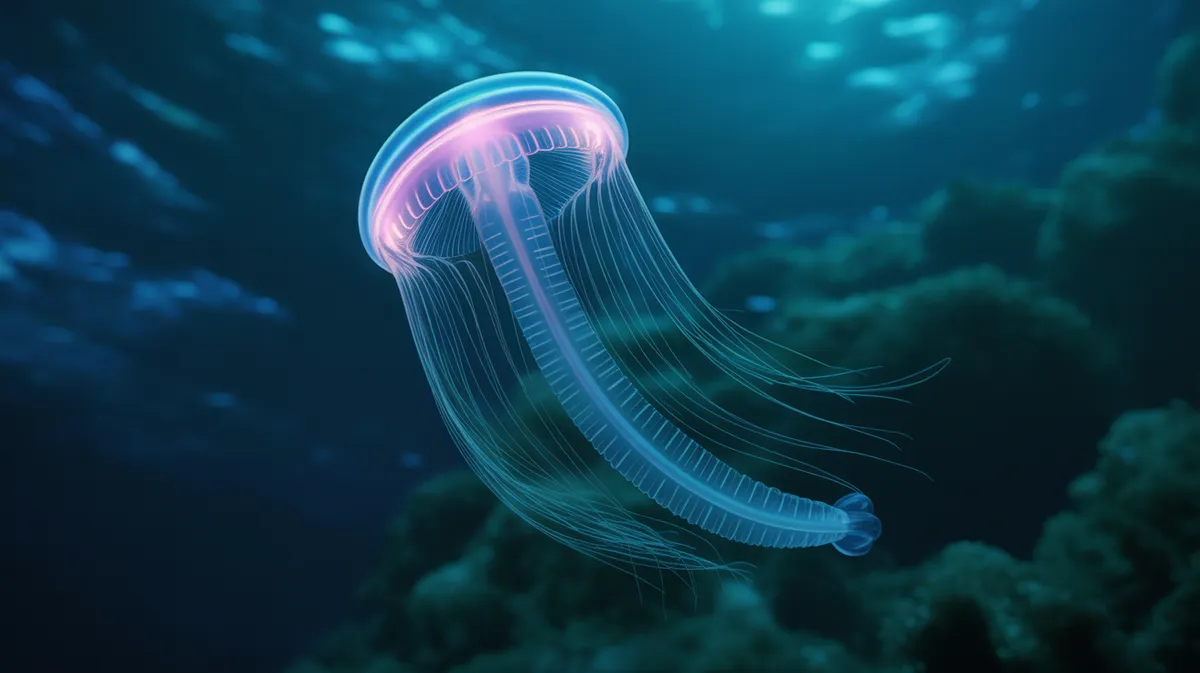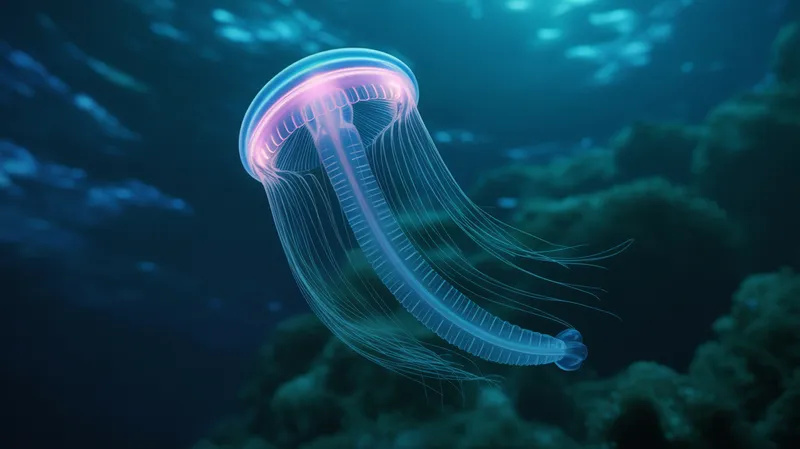
Bioluminescent Comb Jelly
Mnemiopsis leidyi

Meet the Bioluminescent Comb Jelly
The bioluminescent comb jelly, Mnemiopsis leidyi, is a mesmerizing marine invertebrate known for its shimmering, light-producing abilities. Its transparent, oval-shaped body is lined with eight rows of cilia, called 'combs,' which refract light and give the animal an iridescent appearance as it moves gracefully through the water. This species can emit a beautiful bluish-green glow when disturbed, a phenomenon used to startle predators or communicate. Native to the western Atlantic Ocean but now found in many parts of the world, comb jellies play a significant role in marine ecosystems as both predator and prey.
Classification
Invertebrate
Habitat
Coastal and open ocean waters
Diet
Carnivore
Lifespan
1-3 years
Conservation
Least Concern
Weight
2-25 grams
📖Fascinating Facts
Dazzling Light Shows
When agitated, bioluminescent comb jellies emit a bluish-green glow across their bodies, creating spectacular light displays in the ocean.
Unique Feeding Mechanism
Instead of stinging tentacles, they use sticky colloblast cells on their tentacles to trap and eat small zooplankton and larvae.
Global Invader
Originally from the western Atlantic, Mnemiopsis leidyi has spread to the Black, Caspian, and Baltic Seas, where it sometimes disrupts local ecosystems.
📋Detailed Description
Mnemiopsis leidyi, commonly known as the bioluminescent comb jelly, is a lobate ctenophore characterized by its transparent, gelatinous, oval-shaped body, typically ranging from 2 to 12 centimeters in length. Its body is distinguished by eight longitudinal rows of ciliary plates, or 'combs,' which beat in coordinated waves, propelling the animal through the water and producing a rainbow-like iridescence. Unlike true jellyfish, M. leidyi lacks stinging cells (nematocysts) and instead captures prey using sticky cells called colloblasts. The animal's body is composed of over 95% water, making it exceptionally buoyant and delicate. Bioluminescence is produced by specialized photoproteins, emitting a blue-green light when the jelly is physically disturbed, likely serving as a predator deterrent. M. leidyi is hermaphroditic, possessing both male and female reproductive organs, and can self-fertilize, enabling rapid population growth under favorable conditions. It is a voracious predator of zooplankton, fish eggs, and larvae, and its feeding can significantly alter local marine food webs. Native to the temperate and subtropical western Atlantic, it has become a notorious invasive species in the Black, Caspian, Baltic, and North Seas, where it has caused dramatic declines in native fish populations. Its simple body plan and regenerative abilities make it a subject of developmental and evolutionary research.
💡 Did you know?
Comb jellies can reproduce both sexually and asexually, and some individuals are capable of self-fertilization.
🔬Research & Sources
🎭Behavior & Social Structure
Mnemiopsis leidyi is primarily a solitary and nocturnal drifter, moving passively with currents but capable of active locomotion via its ciliary combs. It exhibits opportunistic feeding behavior, extending its lobes to create a feeding current that draws in prey, which is then trapped by colloblasts and transported to the mouth. Feeding activity peaks at night when zooplankton are most abundant near the surface. The species shows little social interaction, though high densities can occur during blooms. M. leidyi can rapidly adjust its vertical position in the water column in response to light, temperature, and prey availability, often aggregating in surface waters during calm, warm conditions. It does not form true social groups, but mass occurrences can lead to intense competition for food.
👶Reproduction & Life Cycle
Mnemiopsis leidyi is a simultaneous hermaphrodite, producing both eggs and sperm, often within the same individual. Spawning occurs daily, typically at night, and is triggered by warm temperatures and abundant food. Fertilization is external, with gametes released directly into the water column. The species is capable of self-fertilization, allowing rapid colonization of new environments. Embryonic development is direct and rapid; eggs can hatch within 24 hours at optimal temperatures (18–24°C). There is no larval stage; juveniles resemble miniature adults and grow quickly, reaching reproductive maturity in as little as two weeks. There is no parental care, and reproductive output can exceed 10,000 eggs per individual per day under ideal conditions.
🛡️Adaptations & Survival
Mnemiopsis leidyi exhibits several key adaptations: its transparent, gelatinous body provides camouflage in open water, while the ciliary combs allow for efficient, silent locomotion. The use of colloblasts instead of nematocysts enables it to capture a wide range of soft-bodied prey. Its bioluminescence, triggered by mechanical stimulation, may deter predators or confuse them during attacks. The ability to self-fertilize and produce large numbers of offspring ensures rapid population growth and colonization, especially in disturbed or new habitats. M. leidyi can tolerate a wide range of salinities (2–38 PSU) and temperatures (2–32°C), contributing to its invasive success. Its regenerative abilities allow it to recover from injury and predation.
📚Research Sources
🎨Cultural Significance
Mnemiopsis leidyi has limited direct cultural significance but has become a symbol of marine invasions and ecosystem disruption, particularly in the Black Sea, where its arrival in the 1980s led to the collapse of commercial fisheries. Its mesmerizing bioluminescence has inspired public fascination and educational displays in aquariums. The species is also used as a model organism in developmental biology and evolutionary research, contributing to our understanding of early animal evolution and regenerative processes.
🔬Recent Research & Discoveries
Recent research has focused on the ecological impact of M. leidyi as an invasive species, particularly its role in altering food webs and outcompeting native zooplanktivores. Genomic studies have revealed unique features of its nervous and muscular systems, shedding light on the evolution of animal complexity. Studies on its bioluminescent proteins have potential applications in biotechnology. Ongoing monitoring in the Baltic and North Seas tracks its spread and population dynamics, while laboratory experiments investigate its reproductive biology and tolerance to environmental stressors. The introduction of the predatory ctenophore Beroe ovata has been studied as a potential biological control in invaded regions.
🎥Wildlife Videos

Bioluminescence in the deep sea: How and why do animals create their own light?
A dive into the deep sea reveals twinkling lights in the midst of darkness. This light doesn't come from the sun—sunlight can't ...
MBARI (Monterey Bay Aquarium Research Institute)

Venus Girdles: Comb Jellies With a Rainbow Glow
Rainbow ribbons of blue and green illuminate the bioluminescent glow of the Venus' girdle. These jellies put on spectacular light ...
Crazy Creatures

Diffraction in Nature The Comb Jelly Fish
Diffraction in Nature. The phenomenon of diffraction can often be seen in nature. Many of you will be aware of the amazing colors ...
francischeefilms

Comb Jelly facts: sticky not stingy | Animal Fact Files
Comb jellies might look a lot like jellyfish, but they aren't! In fact, they completely lack the stinging cells that make jellyfish, well, ...
Animal Fact Files

Jellyfish in the Deep Beautiful, Dangerous & Unknown
Jellyfish – creatures so ancient, yet so mysterious. They have no brain, no heart, and no bones — yet they've ruled the oceans for ...
animals wild

Discovering the Strange and Unusual Creatures of the Deep Ocean | BBC Earth
Below the ocean's surface is a mysterious world that accounts for over 95% of Earth's living space, however the deep sea remains ...
BBC Earth
🌍Habitat Information
The Bioluminescent Comb Jelly typically inhabits Coastal and open ocean waters environments. Bioluminescent Comb Jellys have adapted to their environments with specialized features and behaviors.
Primary Habitat:
Coastal and open ocean waters
More detailed habitat information will be available soon.
🛡️Conservation Status
The Bioluminescent Comb Jelly is currently classified as Least Concern. Conservation efforts are crucial for preserving this species for future generations.
Common Threats:
- 🏠Habitat loss and fragmentation
- 🌡️Climate change impacts
- 🎯Hunting and poaching
- 🏭Human-wildlife conflict
⚠️Threats & Conservation Challenges
In its native range, Mnemiopsis leidyi faces predation from larger ctenophores, jellyfish, and some fish species. However, in invaded ecosystems, it often lacks natural predators, allowing populations to explode. Its main threats are environmental fluctuations, such as hypoxia, pollution, and sudden temperature changes. Human activities, including ballast water transport, have facilitated its spread to new regions, where it poses a significant threat to fisheries by consuming fish eggs and larvae. Population trends are stable in its native range but highly variable elsewhere, with periodic blooms followed by crashes due to food depletion or predation by introduced species such as Beroe ovata.
🔬Scientific Classification
Scientific Name
Mnemiopsis leidyi
Classification Hierarchy
🔍 About Taxonomic Classification
Taxonomic classification is a hierarchical system used by scientists to classify and organize living organisms based on shared characteristics and evolutionary relationships.
The system moves from broad categories (Kingdom) to increasingly specific ones, with each animal's scientific name typically consisting of its Genus and species.
📝Community Notes
Share your observations and insights about the Bioluminescent Comb Jelly with our community of wildlife enthusiasts.
Join Our Community
Sign in to share your observations and connect with fellow wildlife enthusiasts.
Sign In to ContributeNo community notes yet
Be the first to share your observations about the Bioluminescent Comb Jelly!
Explore Bioluminescent Comb Jelly
Select a tab above to learn more about this amazing animal.
📸Photo Gallery
No photos available for this animal yet.
🌟Discover More Wildlife
Continue your journey of discovery with more fascinating animals from our database
